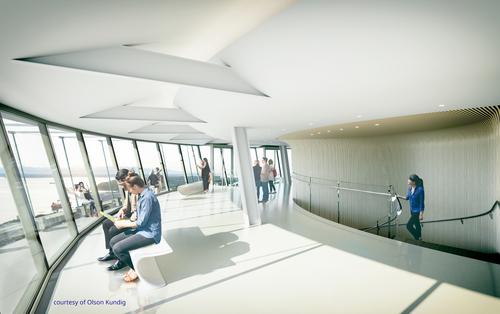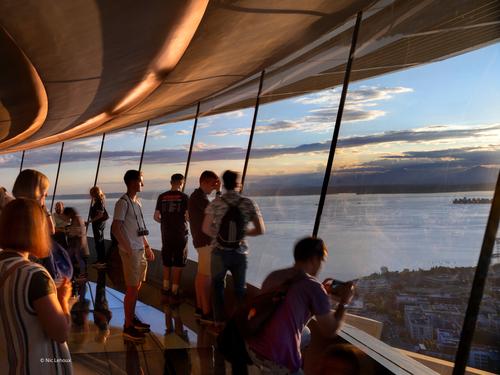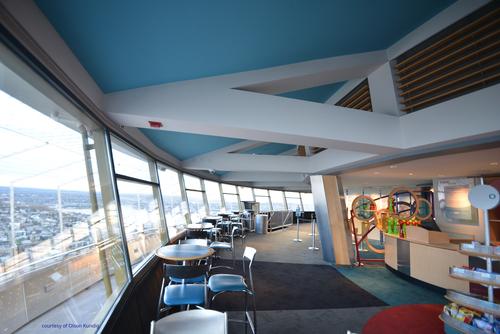Space Needle renovation: Reimagining the iconic landmark with expanded views, historic aesthetic, and updated performance

Built in 1962 for the World’s Fair, the Space Needle stands 605 feet above Seattle and welcomes more than 1.3 million guests from around the world each year. In June 2018, the historic landmark revealed its newly renovated observation decks and celebrated a milestone in its “Century Project,” a multi-year, privately funded, $100 million effort to preserve and enhance the visitor experience for the next 50 years.
In reimagining the building Olson Kundig respected the Space Needle’s conceptual innovation and enduring legacy as originally envisioned by Edward E. Carlson, and as designed by John Graham with Victor Steinbruek, to reflect aspirations of the Space Age. Working with Olson Kundig from the renovation’s earliest stages, glazing consultant and designer Front Inc. specified Technoform’s spacers to help achieve the Space Needle’s design goals.
The challenge
“The Space Needle looked at all the options and decided which had the most value to attract people and keep relevant in the future,” said Front Inc.’s principal, Richard Green, P.E. The renovations not only would enhance value and experience, dramatically expanding the views, but also needed to respect the historic building’s overall appearance.
To accomplish the multiple objectives, more than 176 tons and 10 types of glass replaced entire walls, barriers and floors. Floor-to-ceiling glass on the interior and exterior now offer visitors 360-degree panoramas of the Puget Sound.
Targeting LEED® Gold certification through the U.S. Green Building Council, the Space Needle’s renovation also focused on improving energy performance and controlling condensation risk. As part of the building envelope’s high-performance insulated glazing units (IGUs), Front Inc. selected Technoform TGI®-Spacer M with wire. Meeting the performance requirements were not only important to the building owners, but necessary to meet the Seattle energy code – one of the strictest in the country.
“The project utilized a 196 percent increase in glazed area and also needed to consider the relatively poor thermal performance of the opaque areas, where the existing structure passed from exterior to interior at many points without thermal separation,” explained Technoform’s Helen Sanders, Ph.D. “Because thermal improvements in those opaque areas were limited, the onus was on the glazing to provide excellent energy performance.”
Putting extra demand on the glazing systems to meet the performance requirements, the building’s renovations also could not exceed the capacity of the existing chiller system because removing the old one and replacing it with a bigger one was not an option. Green elaborated, “We knew we could meet the City’s targets, but we had to coordinate quite tightly with the HVAC designers at Arup. We needed to get as good of performance as possible out of the glazing system. Getting the right spacers in there made a difference.”

“The project pushed the envelope not just on glass design, but on the installation process,” said Sanders.
Between autumn of 2017 and summer of 2018, up to 170 people were actively working on the Space Needle’s renovation 20 hours per day, six days a week. More than 500 workers in 18 different trades contributed to the project.
The building remained open to the public during construction. To minimize disruptions, a temporary work platform was built just below the lower observation level. From this perch, Herzog Glass installed the glazing systems on the building envelope at 500- and 520-feet levels. Herzog’s crew monitored wind speeds to ensure safety when hoisting and positioning the heavy, oversized glass units, often having to work during the night.
Thermal separation, condensation resistance, strength
Describing it as a “reverse curtain wall,” Sanders noted: “It created a smooth surface on the inside to allow viewers to have less physical obstructions to getting close up to the glass. As a result, the deep mullions that would have been on the inside are on the outside and act as a heat sink with very little in the way of a thermal break between it and the glass edge.”
Green added, “The only thermal separation we have is in the small thermal spacer [between the mullion and the glass] and in the IGU seals, making Technoform’s spacer super-important in both thermal performance and condensation resistance.” With people sitting right next to the glass in all seasons, the radiant temperature on the interior also would affect the visitors’ comfort.
Helping manage the thermal transfer, Pulp Studio manufactured 8- by 7-foot, double-laminated IGUs with a neutral, triple silver, low-e coating for solar control and anti-reflective coatings to maximize the view. On the edge of glass, Technoform’s 5/8-inch-wide, rigid bar, plastic hybrid stainless steel, warm-edge spacer (TGI-Spacer M with wire) provided the required large thermal break.
“Normally, a warm-edge spacer is considered necessary just in cold weather to keep the interior temperatures warmer compared to the outside. However, in this case the reduction in solar heat gain is a key driver for the use of warm-edge spacer,” said Sanders. On the Space Needle, “the exterior mullion absorbs the solar radiation and then this heat would conduct across the glass edge to the room-side if not for the warm-edge spacer. This thermal break performance helped reduce the cooling load on the chiller, which normally wouldn’t be associated with warm-edge spacer.”
Customized for quality fabrication and appearance
Front Inc.’s attention to detail included specifying black spacers. “It was very much a conscious choice. If you look at the glass from an oblique angle, you may look onto the surface of the spacer. Olson Kundig wanted this to disappear as much as possible and be as little distraction as possible. We did not want to see something bright and shiny,” stated Green.
Along with aesthetics, Green resumed the emphasis on performance, saying, “Spacers tend to be a fabricator’s choice. Many use stainless steel as standard; we needed better.”
Third-party simulations following the National Fenestration Rating Council (NFRC) standards show that using TGI-Spacer M can achieve a 7.5 percent overall system U-value improvement over standard aluminum spacers and equal to non-metal silicone foam spacers for a dual-glazed system. TGI-Spacer M also can increase the condensation resistance rating by 17 percent and improve the sightline temperature up to 12-degrees F.
“Technoform spacer was a product that was specified, but we had never used before,” acknowledged Bernard Lax, Pulp Studio’s chief executive officer. Pulp’s fabrication for insulating glass previously was certified by the Insulating Glass Certification Council (IGCC) using stainless steel spacers.
“IGCC allows standard, stainless steel box spacers to be directly substituted with hybrid, rigid bar, warm-edge spacers – without the need for recertification – because the sealants are bonding to the same durable, solid stainless steel surfaces,” said Sanders.
Green reiterated that the ability for TGI-Spacer M to be used as a direct substitute for stainless steel instead of having to undergo a long IG certification process was critical in meeting the nine-month timeline for the project.
“Technoform’s spacer provides a drop-in solution for fabricators,” echoed Technoform’s Ron Sucik. “Our TGI Spacer-M with wire processes the same way as other rigid bar spacers for insulating glass, but provides a higher performing warm edge solution without sacrificing any durability.”
Sucik continued, “Our focus is to help our customers attain the right combination of performance and aesthetics for their insulating glass products and for their projects’ success. We always spend a significant amount of time on the factory floor to support new customers, making sure that their equipment is optimized and their staff is trained in the best practices of high-quality fabrication with Technoform spacers.”
Lax agreed, “Quality counts for everything and on this iconic project, where glass is everything. Technoform's team was extremely helpful in visiting our location, representing the product and supporting us all the way through the process. Their spacers have now become our go-to material because of this experience.”
Frameless functionality
On the glass walls of The Loupe level, the 7-foot-wide and 10-foot-tall, laminated, IGUs are supported only on the top and the bottom to maximize the view. Even with the very large glass size, because there was no frame around the two vertical edges, the weakest link in the energy performance was the edge of glass.
According to Sanders, Technoform’s TGI-Spacer M with wire was considered the only option to provide both the thermal performance and the necessary edge seal rigidity. “The engineers needed the rigidity of a typical box spacer to manage the localized stresses in the seal area resulting from the special support conditions at the top and bottom of the units, which were required to reduce the displacement of the frameless glass.”
The high-performance IGUs on the Space Needle also have low-iron glass and multiple anti-reflective coatings for minimal glare and high transparency, achieving a museum-grade color rendering index. “Whether you’re in a museum or on an observation deck, you want to see the view as it was intended. You don’t want to have the glass skew the color. It shouldn’t be too yellow or too blue. You want a high quality of natural light,” explained Green.
Adding to the challenge on the restaurant level, the glass had to match the historical dark grey tint of the original design. “It was quite challenging to get the right balance,” admitted Green. “The original restaurant glass only transmitted approximately 26 percent visible light (VLT) to control glare at sunset when operating as a restaurant. The new glass has slightly less VLT but it is very neutral in color, so it’s like putting on expensive new sunglasses – the glare is gone and the color feels like it is enhanced.”
“We’ve been planning this project for years,” said Robert Wallace, glazing foreman of Herzog Glass. “This is a once on a lifetime venture for our team. It’s a custom job that we are privileged to work on. I will never forget it.”
“Herzog did a fantastic job of managing the challenges of what is one of the more complicated installs we have experienced. Things on paper always look like they will work out, but in this case it was their experience that made an impossible task seem like they do jobs like this every day,” complimented Lax. “Projects like this reinvent the wheel.”
The Space Needle was built to help define the skyline of Seattle, but has become so much more,” said Karen Olson, chief marketing officer at the Space Needle. “The Space Needle became the visual icon of the city and a symbol for the spirit of Seattle. The original designers of the Space Needle dreamed big, and we continued their vision with this renovation. With glass walls, glass barriers, glass benches and even glass floors, visitors can feel like they’re floating over the city.”
- Space Needle, 400 Broad St., Seattle, WA 98109
- Owner: Space Needle LLC; Seattle
- Project architect: Olson Kundig; Seattle
- General contractor: Hoffman Construction Company; Portland, Oregon
- Glazing consultant and designer: Front Inc.; Seattle
- Glazing contractor: Herzog Glass; Seattle
- Glazing system – glass fabricator: Pulp Studio, Inc.; Gardena, California
- Glazing system – anti-reflection coatings: Glas Trösch; Thunstetten, Switzerland
- Glazing system – low-e coatings: Vitro Architectural Glass; Cheswick, Pennsylvania
- Glazing system – glass interlayers:
- SentryGlas™ by Kuraray America, Inc.; Houston
- Vanceva, a subsidiary of Eastman Chemical Company; Kingsport, Tennessee
- Glazing system – spacer: Technoform; Twinsburg, Ohio





